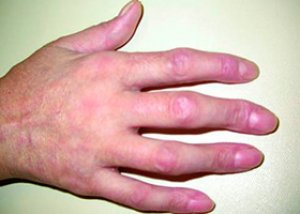
All iLive content is medically reviewed or fact checked to ensure as much factual accuracy as possible.
We have strict sourcing guidelines and only link to reputable media sites, academic research institutions and, whenever possible, medically peer reviewed studies. Note that the numbers in parentheses ([1], [2], etc.) are clickable links to these studies.
If you feel that any of our content is inaccurate, out-of-date, or otherwise questionable, please select it and press Ctrl + Enter.
Mixed connective tissue disease: causes, symptoms, diagnosis, treatment
Medical expert of the article
Last reviewed: 07.07.2025

Mixed connective tissue disease is a rare disorder characterized by the simultaneous presence of manifestations of systemic lupus erythematosus, systemic sclerosis, polymyositis or dermatomyositis, and rheumatoid arthritis with very high titers of circulating antinuclear autoantibodies to ribonucleoproteins (RNP). Development of hand edema, Raynaud's phenomenon, polyarthralgia, inflammatory myopathy, esophageal hypotension, and impaired pulmonary function are characteristic. Diagnosis is based on the analysis of the clinical picture of the disease and the detection of antibodies to RNP in the absence of antibodies characteristic of other autoimmune diseases. Treatment is similar to that for systemic lupus erythematosus and involves the use of glucocorticoids for moderate to severe disease.
Mixed connective tissue disease (MCTD) occurs worldwide in all races, with peak incidence in adolescence and the second decade of life.
Clinical manifestations of mixed connective tissue disease
Raynaud's phenomenon may precede other manifestations of the disease by several years. Often, the first manifestations of mixed connective tissue disease may resemble the onset of systemic lupus erythematosus, scleroderma, rheumatoid arthritis, polymyositis, or dermatomyositis. However, regardless of the nature of the initial manifestations of the disease, the disease tends to progress and spread with a change in the nature of clinical manifestations.
The most common edema is of the hands, especially the fingers, resulting in a sausage-like appearance. Skin changes resemble those seen in lupus or dermatomyositis. Lesions similar to those seen in dermatomyositis, as well as ischemic necrosis and ulceration of the fingertips, are less common.
Almost all patients complain of polyarthralgia, 75% have obvious signs of arthritis. Arthritis usually does not lead to anatomical changes, but erosions and deformations may occur, as in rheumatoid arthritis. Weakness of the proximal muscles is often observed, both with and without pain.
Kidney damage occurs in approximately 10% of patients and is often mild, but in some cases it can lead to complications and death. In mixed connective tissue disease, sensory neuropathy of the trigeminal nerve develops more often than in other connective tissue diseases.
Diagnosis of mixed connective tissue disease
Mixed connective tissue disease should be suspected in all patients with SLE, scleroderma, polymyositis or RA, if additional clinical manifestations develop. First of all, it is necessary to test for the presence of antinuclear antibodies (ARA), antibodies to extractable nuclear antigen and RNP. If the obtained results are consistent with possible MCDT (e.g. very high titer of antibodies to RNA), gamma globulins, complement, rheumatoid factor, antibodies to Jo-1 antigen (histidyl-tRNA synthetase), antibodies to the ribonuclease-resistant component of extractable nuclear antigen (Sm) and DNA double helix should be tested to exclude other diseases. The plan of further investigations depends on the existing symptoms of organ and system involvement: myositis, kidney and lung involvement require the implementation of appropriate diagnostic methods (in particular, MRI, electromyography, muscle biopsy).
Almost all patients have high titers (often >1:1000) of antinuclear antibodies detected by fluorescence. Antibodies to the extractable nuclear antigen are usually present in very high titers (>1:100,000). Antibodies to RNP are characteristically present, while antibodies to the Sm component of the extractable nuclear antigen are absent.
Rheumatoid factor may be detected in fairly high titers. ESR is often elevated.
Prognosis and treatment of mixed connective tissue disease
Ten-year survival is 80%, but the prognosis depends on the severity of symptoms. The main causes of death are pulmonary hypertension, renal failure, myocardial infarction, colon perforation, disseminated infections, and cerebral hemorrhage. Some patients may maintain long-term remission without any treatment.
Initial and maintenance treatment of mixed connective tissue disease resembles that of systemic lupus erythematosus. Most patients with moderate to severe disease respond to glucocorticoid therapy, especially if started early. Mild disease is successfully controlled with salicylates, other NSAIDs, antimalarials, and, in some cases, low-dose glucocorticoids. Severe organ and system involvement requires high-dose glucocorticoids (eg, prednisolone 1 mg/kg once daily, orally) or immunosuppressants. If systemic sclerosis develops, appropriate treatment is given.


 [
[